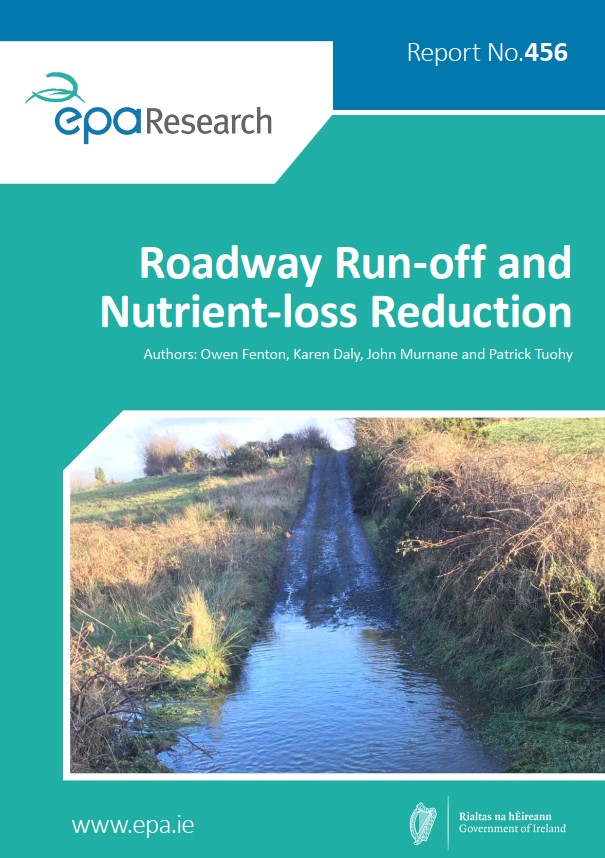Research 456: Roadway Run-off and Nutrient-loss Reduction
Authors: Owen Fenton, Karen Daly, John Murnane and Patrick Tuohy
Summary: The Nitrates Directive aims to protect water quality across Europe by preventing nutrients from agricultural sources, including livestock manures and other fertilisers, from polluting ground and surface waters, and by promoting good farming practices. Ireland’s Nitrates Action Programme states “There shall be no direct runoff of soiled water from farm roadways to waters”. Despite existing regulation, there has been minimal research in Ireland pertaining to the source, content, pathway, mobilisation and impact of roadway runoff. The Roadrunner project reviewed mitigation measures to treat roadway runoff, developed an on-farm visual tool to find and document connectivity between roadway runoff and waters, and provided the evidence base to define roadway runoff as a unique sub-component of the nutrient transfer continuum.

Project highlight video
This feature requires cookies. Open your cookie settings.
Identifying pressures
The Nitrates Directive aims to protect water quality across Europe by preventing nutrients from agricultural sources from polluting ground and surface waters, and by promoting good farming practices. All EU Member States are required to prepare National Nitrates Action Programmes that outline rules for the management and application of livestock manures and other fertilisers. Ireland’s Nitrates Action Programme (Article 17.20) states “There shall be no direct runoff of soiled water from farm roadways to waters”. Despite existing regulation, there has been minimal research in Ireland pertaining to the source, content, pathway, mobilisation and impact of roadway runoff, how to find where runoff interacts with waters, and solutions to help stop this interaction and minimise the consequences of soiled water from farm roadways entering waterways. The Roadrunner project reviewed mitigation measures to treat roadway runoff, developed an on-farm visual tool to find and document connectivity between roadway runoff and waters, and provided the evidence base to define roadway runoff as a unique sub-component of the nutrient transfer continuum.
Informing policy
The Roadrunner project has, for the first time, quantified the scale of the problem of soiled runoff entering our waterways from internal farm roadways. Policymakers should be aware that concentrations of nitrogen and phosphorus in soiled runoff waters are much higher than previously expected, with soiled roadway runoff having a similar profile to dairy-soiled water and even cattle slurry in some cases. Concentrations of phosphorus trapped in sediments on roadways surrounding fields were up to ten times more than anticipated. This trapped phosphorus can remain stored in the ground for long periods, and is released into waterways when it rains. This leads to year-round pollution of waterways, where it was previously thought that this pollution eased when cattle were wintering in sheds. The project also found that soiled waters have the highest risk of entering waterways when they drain into open ditches connected to the farmyard. There are typically 3-4 areas with direct connectivity to waters on any given farm. These findings have direct implications for Ireland’s Nitrates Action Programme.
Developing solutions
To support the mitigation of this problem, the project has identified key intervention points on farmyards where water, soil and sediments can become particularly enriched with nutrients, including: 100 metre radius around the farmyard, underpasses, waiting areas associated with underpasses, water troughs situated along roadways, roadway junctions or anywhere that impedes animal movement – these areas should be targeted to reduce the soiling of runoff waters. The project developed a Farm Roadway Visual Assessment Booklet. This handbook aims to describe visual assessment indicators for identifying the extent of connectivity between roadway runoff and waters; and helps users to examine the structure and configuration of the entire roadway network and evaluate its pollution risk potential. It was co-developed with stakeholders for use by farm advisors, and is a good starting point for those looking to resolve those issues. Other mitigation measures trialed during the project include a low-cost diversion bar which could be placed on roadways at a cost of €100 per unit. However, further validation is required.
https://www.epa.ie/media/epa-2020/research/research-publications/Research-456-Cover-photo.jpg